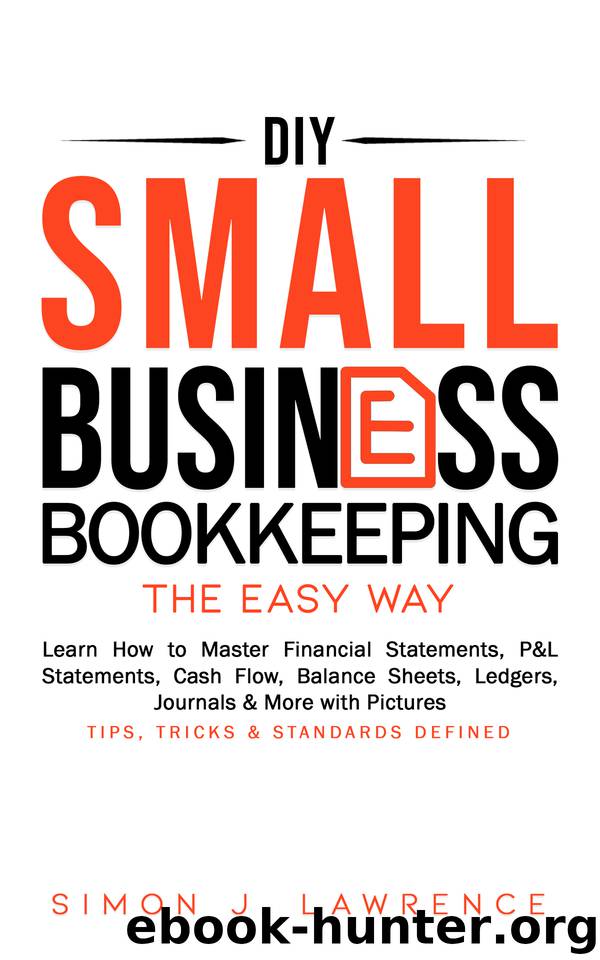DIY Small Business Bookkeeping the Easy Way: Learn How to Master Financial Statements, P&L Statements, Cash Flow, Balance Sheets, Ledgers, Journals & More with Pictures - Tips, Tricks & Standards by Lawrence Simon

Author:Lawrence, Simon [Lawrence, Simon]
Language: eng
Format: epub
Publisher: Lost River Publishing House
Published: 2020-06-14T16:00:00+00:00
How to Prepare Profit/Loss Statement
Step 1: Calculate the Gross Profit/Gross Margin
The income sheet items are systematically arranged on the template. The first item on the list is total revenue, followed by direct costs. If you take your gross revenue and subtract the direct costs, you will end up with a figure referred to as “Gross profit.”
Gross Profit = Gross Revenue - Direct Costs
The first computation on your income sheet should give you the gross profit. An income sheet should also express the gross profit in percentage (Gross margin). The gross margin is depicted as a percentage of the total revenue.
Gross Margin = Gross profit/ Gross Revenue
Example:
Fiona Middleton sells bicycles at an uptown shop. Assuming that she purchased 100 bicycles at the cost of $100 each, her direct cost of running the business within the period of selling 100 bicycles is $100x100= $10,000.
If Fiona sold her bicycles at the price of $200 each, her total revenue was about $20,000. The gross profit for the business would be $10,000. The gross margin would be (10,000/20,000) x 100 =50%.
The gross margin is an indicator of the financial stability of a business. The higher the gross margin percentage, the better. When looking for loans and investors, your gross margin is a measure they use to gauge your business stability.
Step 2: Calculate the EBIT (Earnings Before Interest and Taxes)
EBIT simply refers to the income of business after subtracting the cost of goods and operational expenses. There are different EBIT formulas depending on the complexities of a business. However, it can simply be calculated by subtracting the operating expenses from gross profit.
EBIT= Gross Profit - Operational Costs
Step 3: Calculate the EBT (Earnings Before Tax)
The EBT can tell you a lot about your business. The mistake that most small business managers make is assuming that the gross profit or the EBIT is the actual profit of the business. The EBT gives you a true picture of your business and the future it holds. The EBT can be calculated by subtracting depreciation costs from the EBIT.
EBT= EBIT - Depreciation
Step 4: Calculate the Net Income (Profit /Loss)
After removing all the expenses from your revenue, you are left with a figure that truly reflects your income. However, even the EBT figure above does not reflect the final value of profit.
You now have to subtract indirect expenses. Some of the common indirect expenses include Taxes, Insurance, etc. To calculate your net income, subtract your indirect expenses from your gross profits.
Net profit/loss = Gross profit - Indirect expenses
At the end of your income sheet, you should determine your net profit or loss. It is important to ensure that all the indirect expenses are accounted for. If you fail to include some key expenses, you may get a false profit indication. Ensure that the profit/loss figure that you end up with has accounted for depreciation.
Download
This site does not store any files on its server. We only index and link to content provided by other sites. Please contact the content providers to delete copyright contents if any and email us, we'll remove relevant links or contents immediately.
Zero to IPO: Over $1 Trillion of Actionable Advice from the World's Most Successful Entrepreneurs by Frederic Kerrest(4233)
Machine Learning at Scale with H2O by Gregory Keys | David Whiting(4110)
Never by Ken Follett(3766)
Harry Potter and the Goblet Of Fire by J.K. Rowling(3759)
Ogilvy on Advertising by David Ogilvy(3482)
Shadow of Night by Deborah Harkness(3277)
The Man Who Died Twice by Richard Osman(2980)
Book of Life by Deborah Harkness(2852)
0041152001443424520 .pdf by Unknown(2771)
Will by Will Smith(2771)
My Brilliant Friend by Elena Ferrante(2760)
How Proust Can Change Your Life by Alain De Botton(2726)
The Tipping Point by Malcolm Gladwell(2714)
Purple Hibiscus by Chimamanda Ngozi Adichie(2623)
How to Pay Zero Taxes, 2018 by Jeff A. Schnepper(2578)
Hooked: A Dark, Contemporary Romance (Never After Series) by Emily McIntire(2482)
Rationality by Steven Pinker(2273)
Borders by unknow(2214)
Can't Hurt Me: Master Your Mind and Defy the Odds - Clean Edition by David Goggins(2154)
